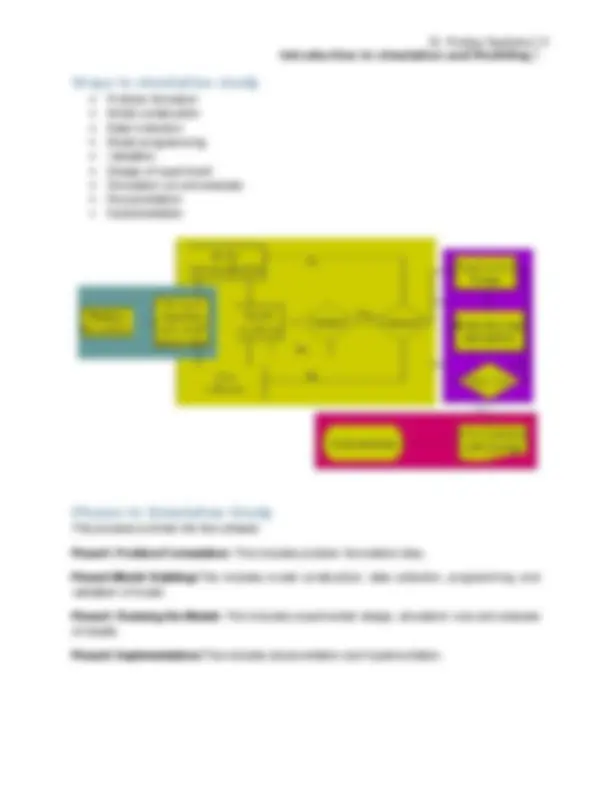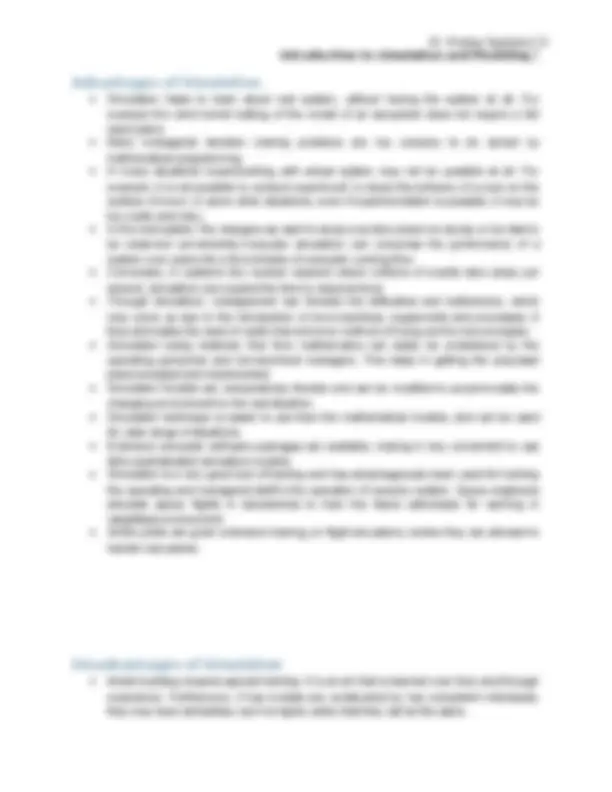





Study with the several resources on Docsity

Earn points by helping other students or get them with a premium plan


Prepare for your exams
Study with the several resources on Docsity

Earn points to download
Earn points by helping other students or get them with a premium plan
Community
Ask the community for help and clear up your study doubts
Discover the best universities in your country according to Docsity users
Free resources
Download our free guides on studying techniques, anxiety management strategies, and thesis advice from Docsity tutors
An introduction to the concepts of simulation and modeling, explaining the importance of systems, their organization, and the role of simulations in understanding and experimenting with them. The definitions of systems, the benefits and uses of simulations, and the different types of simulation models. It also outlines the steps involved in simulation studies.
What you will learn
Typology: Exams
1 / 6

This page cannot be seen from the preview
Don't miss anything!




Introduction to simulation and Modeling
The term system is derive from the Greek word systema, which means an organized relationship among functioning units or components. System exists because it is designed to achieve one or more objectives. We come into daily contact with the transportation system, the telephone system, the accounting system, the production system, and for two decades the computer system. There are more than a hundred definitions of the word system, but most seem to have a common thread that suggests that a system is an orderly grouping of interdependent components linked together according to a plan to achieve a specific objective. The study of the systems concepts, then, has three basic implications:
A system exists and operates in time and space.
A model is a simplified representation of a system at some particular point in time or space intended to promote understanding of the real system.
A simulation is the manipulation of a model in such a way that it operates on time or space to compress it, thus enabling one to perceive the interactions that would not otherwise be apparent because of their separation in time or space.
Simulation is the representation of a real life system by another system, which depicts the important characteristics of the real system and allows experimentation on it. In another word simulation is an imitation of the reality. Simulation has long been used by the researchers, analysts, designers and other professionals in the physical and non-physical experimentations and investigations.
Introduction to simulation and Modeling
It may be too difficult, hazardous, or expensive to observe a real, operational system Parts of the system may not be observable (e.g., internals of a silicon chip or biological system)
Analyze systems before they are built Reduce number of design mistakes Optimize design Analyze operational systems Create virtual environments for training, entertainment
Over the years tremendous developments have taken place in computing capabilities and in special purpose simulation languages, and in simulation methodologies. The use of simulation techniques has also become widespread.
Simulation models can be classified as being static or dynamic, deterministic or stochastic and discrete or continuous. A static simulation model represents a system, which doesnot change with time or represents the system at a particular point in time. Dynamic simulation models represent systems as they change over time. Deterministic models have a known set of inputs, which result into unique set of outputs. In stochastic model , there are one or more random input variables, which lead to random outputs. System in which the state of the system changes continuously with time are called continuous systems while the systems in which the state changes abruptly at discrete points in time called discrete systems.
Introduction to simulation and Modeling
Define Goals and Objectives of Study Develop Conceptual Model Develop Specification of Model Develop Conceptual Model Verify Model
Introduction to simulation and Modeling
Simulation helps to learn about real system, without having the system at all. For example the wind tunnel testing of the model of an aeroplane does not require a full sized plane. Many managerial decision making problems are too complex to be solved by mathematical programming. In many situations experimenting with actual system may not be possible at all. For example, it is not possible to conduct experiment, to study the behavior of a man on the surface of moon. In some other situations, even if experimentation is possible, it may be too costly and risky, In the real system, the changes we want to study may take place too slowly or too fast to be observed conveniently.Computer simulation can compress the performance of a system over years into a few minutes of computer running time. Conversely, in systems like nuclear reactors where millions of events take place per second, simulation can expand the time to required level. Through simulation, management can foresee the difficulties and bottlenecks, which may come up due to the introduction of new machines, equipments and processes. It thus eliminates the need of costly trial and error method of trying out the new concepts. Simulation being relatively free from mathematics can easily be understood by the operating personnel and non-technical managers. This helps in getting the proposed plans accepted and implemented. Simulation Models are comparatively flexible and can be modified to accommodate the changing environment to the real situation. Simulation technique is easier to use than the mathematical models, and can be used for wide range of situations. Extensive computer software packages are available, making it very convenient to use fairly sophisticated simulation models. Simulation is a very good tool of training and has advantageously been used for training the operating and managerial staff in the operation of complex system. Space engineers simulate space flights in laboratories to train the future astronauts for working in weightless environment. Airline pilots are given extensive training on flight simulators, before they are allowed to handle real planes.
Model building requires special training. It is an art that is learned over time and through experience. Furthermore, if two models are constructed by two competent individuals, they may have similarities, but it is highly unlike that they will be the same.